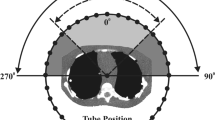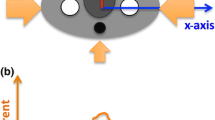Abstract
Objectives
To study the effect of patient size, body region and modulation strength on tube current and image quality on CT examinations that use automatic tube current modulation (ATCM).
Methods
Ten physical anthropomorphic phantoms that simulate an individual as neonate, 1-, 5-, 10-year-old and adult at various body habitus were employed. CT acquisition of head, neck, thorax and abdomen/pelvis was performed with ATCM activated at weak, average and strong modulation strength. The mean modulated mAs (mAsmod) values were recorded. Image noise was measured at selected anatomical sites.
Results
The mAsmod recorded for neonate compared to 10-year-old increased by 30 %, 14 %, 6 % and 53 % for head, neck, thorax and abdomen/pelvis, respectively, (P < 0.05). The mAsmod was lower than the preselected mAs with the exception of the 10-year-old phantom. In paediatric and adult phantoms, the mAsmod ranged from 44 and 53 for weak to 117 and 93 for strong modulation strength, respectively. At the same exposure parameters image noise increased with body size (P < 0.05).
Conclusions
The ATCM system studied here may affect dose differently for different patient habitus. Dose may decrease for overweight adults but increase for children older than 5 years old. Care should be taken when implementing ATCM protocols to ensure that image quality is maintained.
Key Points
• ATCM efficiency is related to the size of the patient’s body.
• ATCM should be activated without caution in overweight adult individuals.
• ATCM may increase radiation dose in children older than 5 years old.
• ATCM efficiency depends on the protocol selected for a specific anatomical region.
• Modulation strength may be appropriately tuned to enhance ATCM efficiency.





Similar content being viewed by others
Abbreviations
- ATCM:
-
Automatic tube current modulation
- CIR:
-
Circumference
- CT:
-
Computed tomography
- HU:
-
Hounsfield unit
- mAsmod :
-
Mean modulated mAs
- ROI:
-
Region of interest
- SD:
-
Standard deviation
- ROI:
-
Region of interest
References
Mulkens TH, Bellinck P, Baeyaert M, Ghysen D, Van Dijck X, Mussen E, Venstermans C, Termote J (2005) Use of an automatic exposure control mechanism for dose optimization in multi–detector row CT examinations: clinical evaluation. Radiology 237:213–223
Rizzo S, Kalra M, Schmidt B, Dalal T, Suess C, Flohr T, Blake M, Saini S (2006) Comparison of angular and combined automatic tube current modulation techniques with constant tube current CT of the abdomen and pelvis. Am J Roentgenol 186:673–679
Kalra M, Maher M, Toth T, Kamath R, Halpern E, Saini S (2004) Comparison of z-axis automatic tube current modulation technique with fixed tube current CT scanning of abdomen and pelvis. Radiology 232:347–353
Papadakis AE, Perisinakis K, Damilakis J (2008) Automatic exposure control in pediatric and adult multi-detector CT examinations: a phantom study on dose reduction and image quality. Med Phys 35:4567–4576
Allen BC, Baker ME, Einstein DM, Remer EM, Herts BR, Achkar JP, Davros W, Novac E, Obuchowski N (2010) Effect of altering automatic exposure settings and image quality reference mAs on radiation dose, image quality, and diagnostic efficacy in MDCT enterography of active inflammatory Crohn’s disease. Am J Roentgenol 195:89–100
McCollough C, Bruesewitz M, Kofler JM (2006) CT dose reduction and dose management tools: overview of available options. Radiographics 26:503–512
Kalra M, Maher M, Kamath R, Horiouchi T, Toth T, Halpern E, Saini S (2004) Sixteen-detector row CT of abdomen and pelvis: study for optimization of z-axis modulation technique performed in 153 patients. Radiology 233:241–249
Solomon JB, Li X, Samei E (2013) Relating noise to image quality indicators in CT examinations with tube current modulation. Am J Roentgenol 200:592–600
Kalra M, Brady T (2006) CARE Dose4D new technique for radiation dose reduction. Siemens Somatom Session 19:28–31
Bredenholler C, Feuerlein U (2006) Somatom sensation 16 application guide. Siemens Medical, Forchheim
Sookpeng S, Martin CJ, Gentle DJ, Lopez-Gonzalez MR (2014) Relationships between patient size, dose and image noise under automatic tube current modulation systems. J Radiol Prot 34:103–123
Söderberg M, Gunnarsson M (2010) The effect of different adaptation strengths on image quality and radiation dose using Siemens Care Dose 4D. Radiat Prot Dosim 139:173–179
Kalra M, Maher M, Toth T, Schmidt B, Westerman B, Morgan H, Saini S (2004) Techniques and applications of automatic tube current modulation for CT. Radiology 233:649–657
Kalender W, Wolf H, Suess C (1999) Dose reduction in CT by anatomically adapted tube current modulation. II. Phantom measurements. Med Phys 26:2248–2253
Papadakis AE, Perisinakis K, Oikonomou I, Damilakis J (2011) Automatic exposure control in pediatric and adult computed tomography examinations: can we estimate organ and effective dose from mean mAs reduction? Investig Radiol 46:654–662
Papadakis AE, Perisinakis K, Damilakis J (2007) Angular on-line tube current modulation in multidetector CT examinations of children and adults: the influence of different scanning parameters on dose reduction. Med Phys 34:2864–2874
Brisse H, Robilliard M, Savignoni A, Pierrat N, Gaboriaud G, De Rycke Y, Neuenschwander S, Aubert B, Rosenwald J (2009) Assessment of organ absorbed doses and estimation of effective doses from pediatric anthropomorphic phantom measurements for multi-detector row CT with and without automatic exposure control. Health Phys 97:303–314
van Straten M, Deak P, Shrimpton P, Kalender W (2009) The effect of angular and longitudinal tube current modulations on the estimation of organ and effective doses in x-ray computed tomography. Med Phys 36:4881–4889
Das M, Mahnken AH, Muhlenbruch G, Stargardt A, Weiss C, Sennst D, Flohr T, Gunther R, Wildberger J (2005) Individually adapted examination protocols for reduction of radiation exposure for 16-MDCT chest examinations. Am J Roentgenol 184:1437–1443
Tack D, De Maertelaer V, Gevenois P (2003) Dose reduction in multidetector CT using attenuation-based online tube current modulation. Am J Roentgenol 181:331–334
Greess H, Lutze J, Nomayr A, Wolf H, Horhorn T, Kalender W, Bautz W (2004) Dose reduction in subsecond multislice spiral CT examination of children by on-line tube current modulation. Eur Radiol 14:995–999
Papadakis AE, Perisinakis K, Raissaki M, Damilakis J (2013) Effect of x-ray tube parameters and iodine concentration on image quality and radiation dose in cerebral pediatric and adult CT angiography. Investig Radiol 48:192–199
Acknowledgements
The scientific guarantor of this publication is Antonios E Papadakis. The authors of this manuscript declare no relationships with any companies whose products or services may be related to the subject matter of the article. The authors state that this work has not received any funding. No complex statistical methods were necessary for this paper. Institutional review board approval was not required because this study was performed on anthropomorphic phantoms. Methodology: experimental, performed at one institution.
Author information
Authors and Affiliations
Corresponding author
Rights and permissions
About this article
Cite this article
Papadakis, A.E., Perisinakis, K. & Damilakis, J. Automatic exposure control in CT: the effect of patient size, anatomical region and prescribed modulation strength on tube current and image quality. Eur Radiol 24, 2520–2531 (2014). https://doi.org/10.1007/s00330-014-3309-4
Received:
Revised:
Accepted:
Published:
Issue Date:
DOI: https://doi.org/10.1007/s00330-014-3309-4




